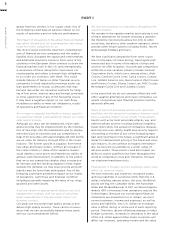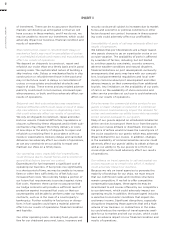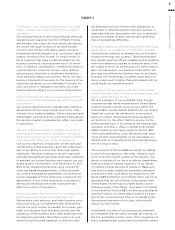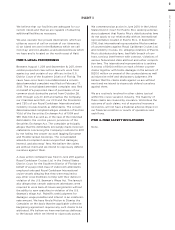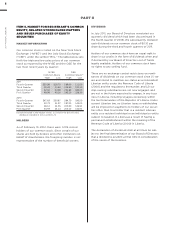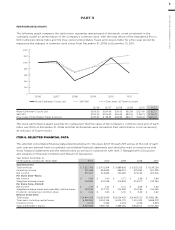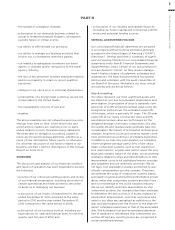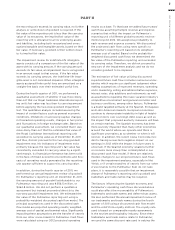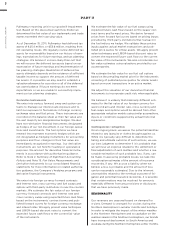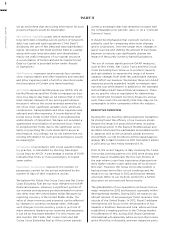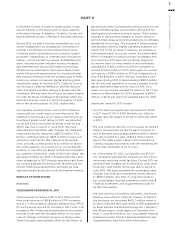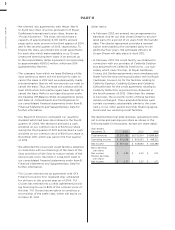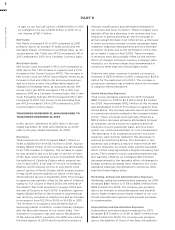Royal Caribbean Cruise Lines 2011 Annual Report Download - page 44
Download and view the complete annual report
Please find page 44 of the 2011 Royal Caribbean Cruise Lines annual report below. You can navigate through the pages in the report by either clicking on the pages listed below, or by using the keyword search tool below to find specific information within the annual report.
2011 ANNUAL REPORT 40
PART II
We use the deferral method to account for drydocking
costs. Under the deferral method, drydocking costs
incurred are deferred and charged to expense on a
straight-line basis over the period to the next sched-
uled drydock, which we estimate to be a period of
thirty to sixty months based on the vessel’s age as
required by Class. Deferred drydock costs consist
of the costs to drydock the vessel and other costs
incurred in connection with the drydock which are
necessary to maintain the vessel’s Class certification.
Class certification is necessary in order for our cruise
ships to be flagged in a specific country, obtain liability
insurance and legally operate as passenger cruise
ships. The activities associated with those drydocking
costs cannot be performed while the vessel is in ser-
vice and, as such, are done during a drydock as a
planned major maintenance activity. The significant
deferred drydock costs consist of hauling and wharf-
age services provided by the drydock facility, hull
inspection and related activities (e.g., scraping, pres-
sure cleaning, bottom painting), maintenance to steer-
ing propulsion, stabilizers, thruster equipment and
ballast tanks, port services such as tugs, pilotage and
line handling, and freight associated with these items.
We perform a detailed analysis of the various activities
performed for each drydock and only defer those
costs that are directly related to planned major main-
tenance activities necessary to maintain Class. The
costs deferred are not otherwise routinely periodically
performed to maintain a vessel’s designed and intended
operating capability. Repairs and maintenance activi-
ties are charged to expense as incurred.
We use judgment when estimating the period between
drydocks, which can result in adjustments to the esti-
mated amortization of drydock costs. If the vessel is
disposed of before the next drydock, the remaining
balance in deferred drydock is written-off to the gain
or loss upon disposal of vessel in the period in which
the sale takes place. We also use judgment when
identifying costs incurred during a drydock which are
necessary to maintain the vessel’s Class certification
as compared to those costs attributable to repairs and
maintenance which are expensed as incurred. (See
Note 2. Summary of Significant Accounting Policies to
our consolidated financial statements under Item 8.
Financial Statements and Supplementary Data.)
We believe we have made reasonable estimates for
ship accounting purposes. However, should certain
factors or circumstances cause us to revise our esti-
mates of ship useful lives or projected residual values,
depreciation expense could be materially higher or
lower. If circumstances cause us to change our assump-
tions in making determinations as to whether ship
improvements should be capitalized, the amounts we
expense each year as repairs and maintenance costs
could increase, partially offset by a decrease in depre-
ciation expense. If we had reduced our estimated
average 30-year ship useful life by one year, depre-
ciation expense for 2011 would have increased by
approximately $27.0 million. If our ships were estimated
to have no residual value, depreciation expense for 2011
would have increased by approximately $143.0 million.
Valuation of Long-Lived Assets, Goodwill and
Indefinite-Lived Intangible Assets
We review our ships and other long-lived assets for
impairment whenever events or changes in circum-
stances indicate, based on estimated undiscounted
future cash flows, that the carrying amount of these
assets may not be fully recoverable. We evaluate asset
impairment for our ships on an individual basis at the
lowest level for which identifiable cash flows are
largely independent of the cash flows of other assets
and liabilities. The lowest level for which we maintain
identifiable cash flows that are independent of the
cash flows of other assets and liabilities is at the ship
level. (See Note 2. Summary of Significant Accounting
Policies to our consolidated financial statement under
Item 8. Financial Statements and Supplementary
Data.) If estimated future cash flows are less than the
carrying value of an asset, an impairment charge is
recognized for the difference between the asset’s
estimated fair value and its carrying value.
We estimate fair value based on quoted market prices
in active markets, if available. If active markets are not
available, we base fair value on independent apprais-
als, sales price negotiations and projected future cash
flows discounted at a rate estimated by management
to be commensurate with the business risk. Quoted
market prices are often not available for individual
reporting units and for indefinite-life intangible assets.
Accordingly, we estimate the fair value of a reporting
unit and an indefinite-life intangible asset using an
expected present value technique.
We review goodwill, trademarks and tradenames,
which are our most significant indefinite-lived intangi-
ble assets, for impairment at the reporting unit level
annually or, when events or circumstances dictate,
more frequently. The impairment review for goodwill
consists of a qualitative assessment of whether it is
more-likely-than-not that a reporting unit’s fair value
is less than its carrying amount, followed by a two-step
process of determining the fair value of the reporting
unit and comparing it to the carrying value of the net
assets allocated to the reporting unit. If the qualitative
assessment demonstrates that it is more-likely-than-
not that the estimated fair value of the reporting unit
exceeds its carrying value, it is not necessary to per-
form the two-step goodwill impairment test. We may
elect to bypass the qualitative assessment and proceed
directly to step one, for any reporting unit, in any
period. We can resume the qualitative assessment for
any reporting unit in any subsequent period. When
performing the two-step process, if the fair value of


